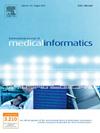Insights from high and low clinical users of telemedicine: a mixed-methods study of clinician workflows, sentiments, and user experiences
IF 4.1
2区 医学
Q2 COMPUTER SCIENCE, INFORMATION SYSTEMS
International Journal of Medical Informatics
Pub Date : 2025-07-09
DOI:10.1016/j.ijmedinf.2025.106044
引用次数: 0
Abstract
Background
Teleconsultation is a valuable tool in healthcare, but systematic evaluation of workflow processes (comparing teleconsultation to in-person visits) and the nuanced experiences of high and low clinical users of teleconsultation services is lacking. Understanding if and where differences exist is important to improve adoption and optimise service delivery. Our study objectives are: (1) To compare the process and workflow of teleconsultations and in-person consultations, identifying and quantifying if and where differences arise. (2) To examine clinicians’ experiences of teleconsultations, identifying barriers and enablers, and whether these differ between high and low providers.
Methods
We conducted a mixed-method study to explore workflow and clinician experiences with vCare (an outpatient chronic disease teleconsultation service run at Alexandra Hospital) versus in-person consultations. A time and motion study (n = 60 observations of individual consultations) quantified the task type and average duration for a teleconsultation and in-person visit. We also collected qualitative data (interviews and focus group discussions (n = 18)) from high and low-clinician users (physicians, nurses, and pharmacists) to understand clinical user experiences, barriers and enablers of vCare uptake. We defined low clinical users as clinicians who opted for vCare in less than <10 % of their monthly appointment time. Data were analysed using sentiment scoring and framework analysis, guided by the Consolidated Framework for Implementation Research (CFIR).
Results
Teleconsultation time was shorter; 10 mins versus 15 min (mean difference 4 min 42 s, p < 0.001, confidence interval (CI) 2 min 25 s, 7 min), with less time spent on history taking (mean difference 58 s, p = 0.01, CI 12.9, 103.1) and patient discussion (mean difference 1 min 34 s, p = 0.03, CI 7.1, 180.3) compared to in-person consultations. High clinical vCare users expressed more positive sentiments towards teleconsultation than low clinical users (composite sentiment score 0.1860 versus 0.1225), particularly in the CFIR Implementation Process domain (high user: 0.276 and low user: −0.099). Regarding barriers and enablers, high and low clinical users aligned on several factors, including the impact of infrastructure quality, suitability of patients, costs, policy, and stakeholder buy-in. Unique uptake barriers from high clinical users included liability concerns, language barriers and health literacy. For low clinical users, the need for reminders, fatigue from teleconsultations, and challenges in providing emotional support were influencing factors.
Conclusion
Integrating quantitative and qualitative data revealed key process differences between tele- and in-person consultations, as well as variations in clinician experience among high and low clinical users of teleconsultation. Developing tailored strategies to support the distinct needs of different providers is necessary to improve teleconsultation practice and adoption.
来自远程医疗的高、低临床用户的见解:临床医生工作流程、情绪和用户体验的混合方法研究
远程会诊在医疗保健中是一种有价值的工具,但缺乏对工作流程的系统评估(将远程会诊与面对面就诊进行比较)以及远程会诊服务的高、低临床用户的细微体验。了解差异是否存在以及在哪里存在,对于改进采用和优化服务交付非常重要。我们的研究目标是:(1)比较远程咨询和面对面咨询的过程和工作流程,确定和量化是否和在哪里出现差异。(2)检查临床医生的远程咨询经验,识别障碍和促进因素,以及这些因素在高、低提供者之间是否存在差异。方法我们进行了一项混合方法研究,以探索与面对面咨询相比,vCare (Alexandra医院运行的门诊慢性病远程咨询服务)的工作流程和临床医生的经验。一项时间和行动研究(n = 60次个人咨询观察)量化了远程咨询和亲自就诊的任务类型和平均持续时间。我们还收集了来自高、低临床医生用户(医生、护士和药剂师)的定性数据(访谈和焦点小组讨论(n = 18)),以了解临床用户体验、障碍和vCare吸收的推动因素。我们将低临床用户定义为选择vCare的临床医生少于每月预约时间的10%。在实施研究统一框架(CFIR)的指导下,使用情绪评分和框架分析对数据进行分析。结果咨询时间较短;10分钟vs 15分钟(平均差4分钟42秒,p <;0.001,可信区间(CI) 2分25秒,7分钟),与面对面咨询相比,记录病史(平均差58秒,p = 0.01, CI 12.9, 103.1)和患者讨论(平均差1分34秒,p = 0.03, CI 7.1, 180.3)花费的时间更少。高临床vCare用户比低临床用户对远程咨询表达了更多的积极情绪(综合情绪得分0.1860比0.1225),特别是在CFIR实施过程领域(高用户:0.276,低用户:- 0.099)。关于障碍和推动因素,高、低临床用户在几个因素上保持一致,包括基础设施质量的影响、患者的适宜性、成本、政策和利益相关者的支持。来自高临床用户的独特吸收障碍包括责任问题、语言障碍和卫生知识普及。对于低临床用户,需要提醒,远程咨询的疲劳,以及在提供情感支持方面的挑战是影响因素。结论整合定量和定性数据揭示了远程会诊和面对面会诊的关键流程差异,以及远程会诊的高、低临床用户的临床医生经验差异。制定量身定制的战略,以支持不同提供者的独特需求,对于改善远程咨询的实践和采用是必要的。
本文章由计算机程序翻译,如有差异,请以英文原文为准。
求助全文
约1分钟内获得全文
求助全文
来源期刊

International Journal of Medical Informatics
医学-计算机:信息系统
CiteScore
8.90
自引率
4.10%
发文量
217
审稿时长
42 days
期刊介绍:
International Journal of Medical Informatics provides an international medium for dissemination of original results and interpretative reviews concerning the field of medical informatics. The Journal emphasizes the evaluation of systems in healthcare settings.
The scope of journal covers:
Information systems, including national or international registration systems, hospital information systems, departmental and/or physician''s office systems, document handling systems, electronic medical record systems, standardization, systems integration etc.;
Computer-aided medical decision support systems using heuristic, algorithmic and/or statistical methods as exemplified in decision theory, protocol development, artificial intelligence, etc.
Educational computer based programs pertaining to medical informatics or medicine in general;
Organizational, economic, social, clinical impact, ethical and cost-benefit aspects of IT applications in health care.
 求助内容:
求助内容: 应助结果提醒方式:
应助结果提醒方式:


